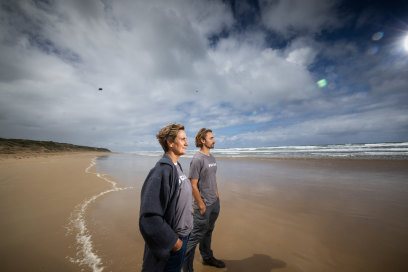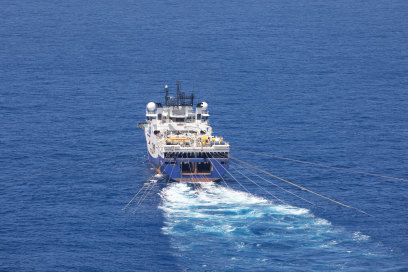- Exclusive
- Environment
- Conservation
- Gas
This was published 1 year ago
‘Doesn’t pass the pub test’: Push for moratorium on seismic blasting
By Bianca Hall
Liberal Bridget Archer and teal independent Monique Ryan – hailing from opposite ends of the Otway Basin, and of differing political persuasions – will this week team up in federal parliament to try to force a vote on the future of seismic testing.
More than 2000 seismic surveys have been conducted in Australian waters since the 1960s, as companies map the seabed to prospect for new oil and gas reserves. Mapping companies then sell the information to oil and gas companies.

Lisa Deppeler, pictured with fellow campaigner Mitch Pope, describes seismic testing as Australia’s secret.Credit: Jason South
Seismic testing is the use of high-powered underwater air guns towed behind a ship that release sound blasts at regular intervals – as high as 250 decibels – to record echoes of geological formations below the seabed.
In September, multinational oil and gas exploration companies TGS and SLB-Schlumberger withdrew a seismic surveying bid that initially proposed to survey more than 7 million hectares of ocean off Victoria, South Australia and Tasmania.
After reducing the size of the area to be surveyed, TGS scrapped the bid entirely in the face of widespread and concerted community opposition.
Lisa Deppeler, from the community-based Otway Climate Emergency Action Network, said campaigners would now turn their sights to another seismic survey proposed for the Otway Basin.

Woodside’s seismic testing vessel conducts operations off the Pilbara coast in December last year.Credit: Emma Dolzadelli, Minderoo Foundation
“We called it a seismic secret because 99.9 per cent of Australians didn’t know it was going on. I think it’s still close to that figure.”
Ryan and Archer will on Monday seek to introduce a bill that would end the use of Special Prospect Authority (SPA) permits, which allow companies to conduct unlimited speculative seismic tests – including in marine parks – over a 180-day period.
Ryan said it was significant that her bill was being supported by Archer.
“It really demonstrates that this is not a partisan issue ... We know that there are members of the government who care about it as well.”
Companies are not required to share the information they garner from seismic testing, which Ryan described as a regulatory failure.
“It makes no sense that we subject the ocean and the ocean floor to the same examination again and again by different people at different times, and they don’t share the information that they have.”
EnerGeo Alliance is a global trade alliance for the energy geoscience industry.
Its Asia-Pacific representative, Simon Molyneux, said more than 2000 seismic surveys had been conducted in Australian waters since the 1960s, including hundreds off the coast of Victoria and around Tasmania, “with no evidence of the impacts many opponents have claimed as likely”.
“The seismic industry has a long and strong track record of operating safely, sustainably and successfully in Australian waters,” he said.
“It is subject to robust regulation and only performs activity after extensive consultation with local communities and stakeholders and environmental review.”
The ABC reported in 2020 that whiting catch rates at Lakes Entrance, where CGG Services was conducting seismic testing, were down 99.5 per cent after surveying.
A Senate inquiry into seismic testing in 2021 recommended the Australian government investigate and support alternatives to seismic testing to reduce the potential impact on marine animals and the marine environment.
It also recommended the government consider imposing a levy on oil and gas companies that conduct seismic testing, to fund research into the impacts on marine animals and the marine environment.
Archer, the federal member for Bass, said the effects of seismic testing on marine life were increasingly known.
“I think the time is now to press pause and have a look at this and get some reform in this area.”
The Australian Marine Conservation Society has been campaigning against the granting of new SPA permits, with one project now under application in the Otway Basin.
That project, by CGG, would allow seismic testing in a vast stretch of about 4000 square kilometres of ocean between Port Campbell and Port Fairy. CGG declined to comment.
Oil and gas campaign manager Louise Morris said the current permit system offered companies a low bar for seismic survey permits, and “doesn’t pass the pub test”.
She called for existing mapping to be made publicly available through Geoscience Australia for reprocessing, to “reduce that demand for any new seismic in areas of ocean which have been blasted so many times before”.
“Our large animals such as pygmy blue whales and southern right whales, which use these oceans as foraging, calving and migration routes, the impact of seismic blast into their hearing is commensurate with how close they are, but it’s been proven to both damage in the short term and if they’re too close, damage in the long term.”
Research by scientists at Curtin University in 2017 measured the levels of dead krill after seismic surveys, finding two to three times as many dead zooplanktons after surveying, over a range of 1.2 kilometres.